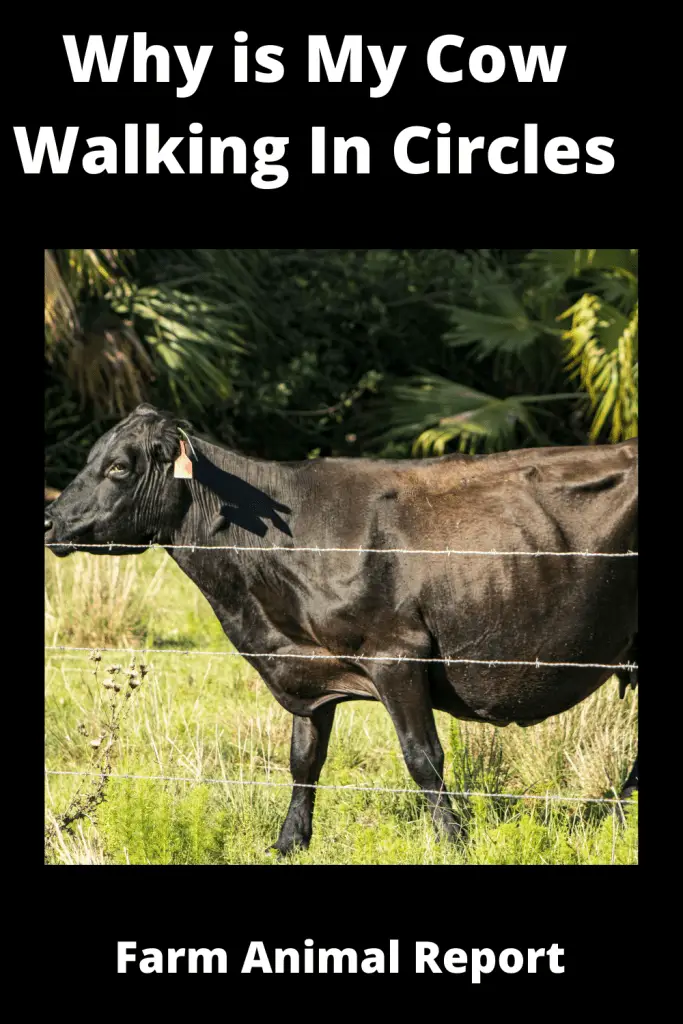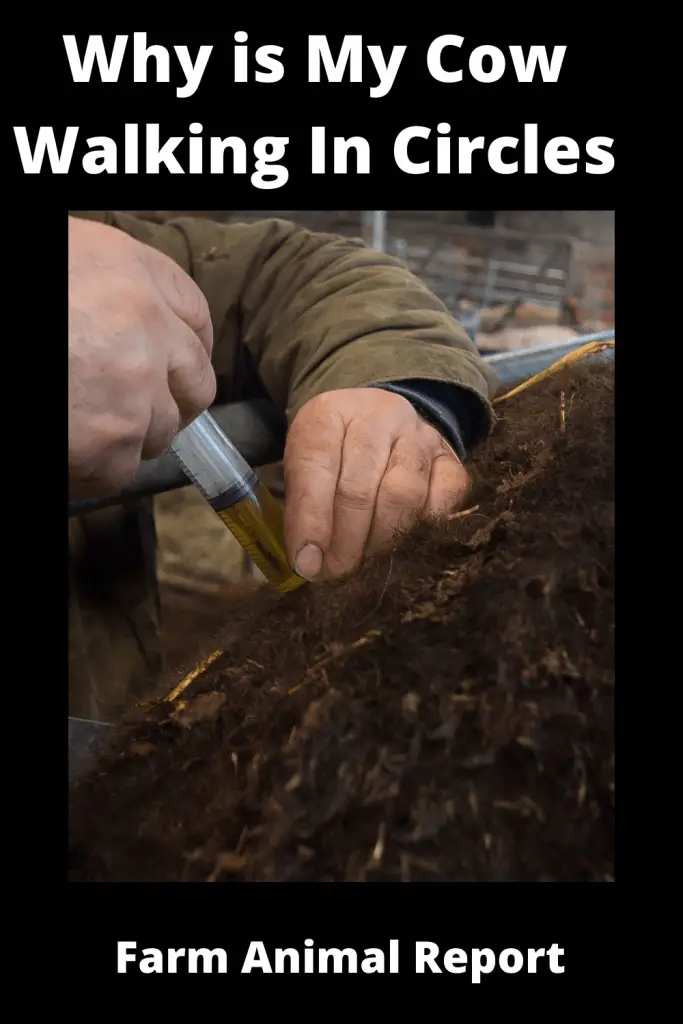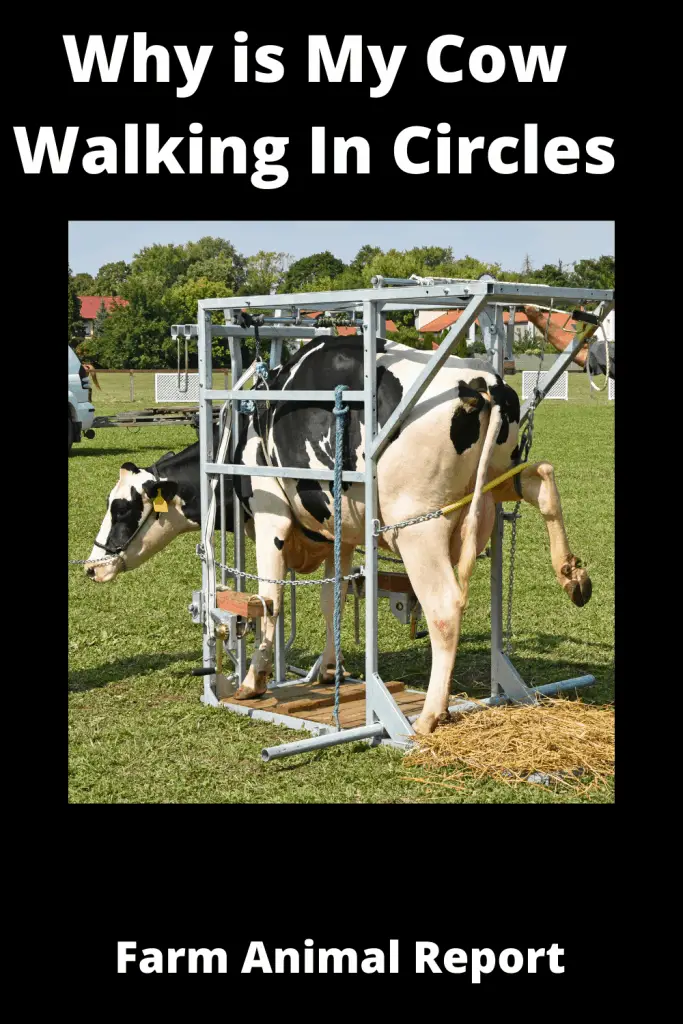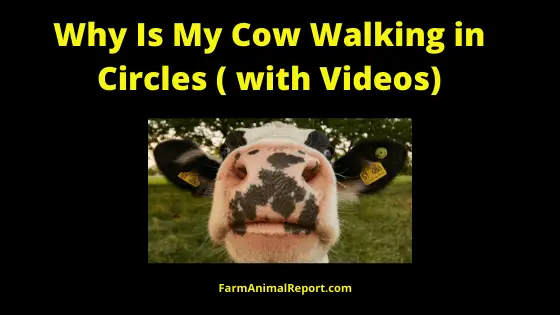Why is My Cow Walking In Circles
Why is My Cow Walking In Circles – If you are interested in commercial Cattle farming Homesteading, or Free Range Farming, or you and are Struggling with Why Your Cow is walking In Circles. If You are thinking about Raising Cattle, and you want to know about the selection of animals, feeding guidelines, and their management. Our Articles Reference an Article w/ Videos, the Majority written by Veterinarians.
Listeriosis / Circling Disease / Silage Sickness
The circling movement of cows is due to a disease of cattle called Listeriosis, also called Circling Disease or Silage Sickness of cows. It is a disease of worldwide occurrence that can affect all ruminants as well as other animal species and humans. Listeriosis is a sporadic bacterial infection that affects a wide range of animals, including people and birds. It is seen worldwide, more frequently in temperate and colder climates. There is a high incidence of intestinal carriers. Encephalitis or meningoencephalitis in adult ruminants is the most frequently recognized form.
Etiology and Epidemiology:
Listeria monocytogenes is a small, motile, gram-positive, nonperforming, extremely resistant, diphtheroid coccobacillus that grows under a wide temperature range 39 – 112 Degrees F, 4°–44°C. Its ability to grow at 39 Degrees F – 4°C is an important diagnostic aid (the “cold enrichment” method) for isolation of the organism from brain tissue but not from placental or fetal tissues. Primary isolation is enhanced under microaerophilic conditions. It is a ubiquitous saprophyte that lives in a plant-soil environment and has been isolated in ~42 species of domestic and wild mammals and 22 species of birds, as well as fish, crustaceans, insects, sewage, water, silage and other feedstuffs, milk, cheese, meconium, feces, and soil.

Eaten then Passed Thru Feces
The natural reservoirs of L monocytogenes appear to be soil and mammalian GI tracts, both of which contaminate vegetation. Grazing animals ingest the organism and further contaminate vegetation and soil. Animal-to-animal transmission occurs via the fecal-oral route.
Listeriosis is primarily a winter-spring disease of feedlot or housed ruminants. The less acidic pH of spoiled silage enhances the multiplication of L monocytogenes. Outbreaks typically occur ≥10 days after feeding poor-quality silage.
Removal or change of silage in the ration often stops the spread of listeriosis; feeding the same silage months later may result in new cases.
Pathogenesis:
Listeria organisms that are ingested or inhaled tend to cause septicemia, abortion, and latent infection. Those that gain entry to tissues have a predilection to localize in the intestinal wall, medulla oblongata, and placenta or to cause encephalitis via minute wounds in the buccal mucosa. The various manifestations of infection occur in all susceptible species and are associated with characteristic clinical syndromes: abortion and perinatal mortality in all species, encephalitis or meningoencephalitis in adult ruminants, septicemia in neonatal ruminants and monogastric animals, and septicemia with myocardial or hepatic necrosis (or both) in poultry.
Circling / Facial Paralysis / Depression
Listeria encephalitis affects sheep, cattle, goats, and occasionally pigs. It is essentially a localized infection of the brain stem that develops when L monocytogenes ascends the trigeminal nerve. Clinical signs vary according to the function of damaged neurons but often are unilateral and include depression (ascending reticular activating system), ipsilateral weakness (long tracts), trigeminal and facial nerve paralysis, and less commonly, circling (vestibulocochlear nucleus). Neurologic signs indicating bilateral cranial nerve deficits are occasionally seen in lambs.
Septicemic or visceral listeriosis is most common in monogastric animals, including pigs, dogs, cats, domestic and wild rabbits, and many other small mammals. These animals may play a role in the transmission of L monocytogenes. This form is also found in young ruminants before the rumen is functional. Although rare, septicemia has been reported in older domestic ruminants and deer. The septicemic form affects organs other than the brain, the principal lesion being focal hepatic necrosis.
See Our Guide – Ways to Make Money Cattle Farming
The uterus of all domestic animals, especially ruminants, is susceptible to infection with L monocytogenes at all stages of pregnancy, which can result in placentitis, fetal infection and death, abortion, stillbirths, neonatal deaths, metritis, and possibly viable carriers. The metritis has little or no effect on subsequent reproduction; however, Listeria may be shed for ≥1 mo via the vagina and milk.

Infections acquired via ingestion tend to localize in the intestinal wall and result in prolonged fecal excretion. It has been postulated that contaminated silage results in latent infections, often approaching 100% of the exposed herd or flock, but clinical listeriosis in only a few animals.
Symptoms
- Depression
- Loss of appetite
- Fever
- Lack of coordination (animals seen going around in circles)
- Isolation from herd
- Salivation
- Facial paralysis
- Abortions
- Stillbirths
- Encephalitis (inflammation of the brain)
- Blood poisoning
Encephalitis is the most readily recognized form of listeriosis in ruminants. It affects all ages and both sexes, sometimes as an epidemic in feedlot cattle or sheep.
The course in sheep and goats is rapid, and death may occur 24–48 hr after onset of signs;
however, the recovery rate can be up to 30% with prompt, aggressive therapy. In cattle, the course is less acute, and the recovery rate approaches 50%. Lesions are localized in the brain stem, and the signs indicate dysfunction of nerve nuclei, including those of the third to seventh cranial nerves.
Affected Animals Symptoms – Encephalitis
- Depression
- Disoriented
- Leaning
- Circling
- Drooping Ear
- More
Initially, affected animals are anorectic, depressed, and disoriented. They may propel themselves into corners, lean against stationary objects, or circle toward the affected side. Facial paralysis with a drooping ear deviated muzzle, flaccid lip, and lowered eyelid often develops on the affected side, as well as lack of a menace response and profuse, almost continuous, salivation; food material often becomes impacted in the cheek due to paralysis of the masticatory muscles. Terminally affected animals fall and, unable to rise, lie on the same side; involuntary running movements are common.
Listeria encephalitis may recur on the same premises in successive years. The number of animals clinically involved in an outbreak usually is <2% but in exceptional circumstances may reach 10%–30% in a flock of sheep.
Listeria Abortion
Listeria abortion usually occurs in the last trimester without premonitory signs. Fetuses usually die in utero, but stillbirths and neonatal deaths occur. The abortion rate varies and may reach 20% in sheep flocks. Fatal septicemia of the dam secondary to metritis is rare. Encephalitis and abortion usually do not occur simultaneously in the same herd or flock. However, the clinical pattern in sheep in the UK has been changing; abortions, encephalitis, and diarrhea are increasing, and outbreaks of abortions and encephalitis occur together in the same flock.
Listeriosis is relatively uncommon in pigs, with septicemia occurring in those <1 mo old and encephalitis in older pigs; it has a rapid, fatal course of 3–4 days.
Lesions:
In listeria encephalitis, there are few gross lesions except for some congestion of meninges. Microscopic lesions are confined primarily to the pons, medulla oblongata, and anterior spinal cord.
In septicemic listeriosis, small necrotic foci may be found in any organ, especially the liver. In calves that die when <3 wk old, in addition to focal hepatic necrosis, there is frequently marked hemorrhagic gastroenteritis.
In aborted fetuses, there is slight to marked autolysis, clear to blood-tinged fluid in the serous cavities, and numerous small necrotic foci in the liver, especially in the right half. Necrotic foci may be found in other viscera such as lung and spleen. Shallow erosions, 1–3 mm, may be present in abomasal mucosa. Autolytic changes may mask these lesions. Gram-stained smears of abomasal contents reveal numerous gram-positive, pleomorphic coccobacilli.
Diagnosis:
Samples of lumbosacral CSF can be collected under local anesthesia. In cases of listeriosis, the CSF has an increased protein concentration (0.6–2 g/L [normal 0.3 g/L]) and a mild pleocytosis composed of large mononuclear cells.
Listeriosis is confirmed only by isolation and identification of L monocytogenes. Specimens of choice are brain from animals with CNS involvement and aborted placenta and fetus. If primary isolation attempts fail, ground brain tissue should be held at 4°C (39°F) for several weeks and recultured weekly. Occasionally, L monocytogenes has been isolated from spinal fluid, nasal discharge, urine, feces, and milk of clinically ill ruminants. Serology is not used routinely for diagnosis, because many healthy animals have high Listeria titers. Immunofluorescence is effective for rapidly identifying L monocytogenes in smears from animals dead or aborted from listeriosis and from milk, meat, and other sources.

Listeriosis or Rabies
Listeriosis can be differentiated from pregnancy toxemia in ewes or ketosis in cattle by careful clinical examination, CSF changes, and 3-OH butyrate concentrations well below 3 mmol/L. Furthermore, facial and ear paralysis are absent in pregnancy toxemia or ketosis. In cattle, the unilateral signs of trigeminal and facial paralysis (often subtle) help differentiate listeriosis from bovine spongiform encephalopathy, thrombotic meningoencephalitis, polio encephalomalacia, sporadic bovine encephalomyelitis, and lead poisoning. Rabies must always be considered in the differential diagnosis of listeriosis. Animals with brain abscesses and coenuruses present with circling, contralateral blindness, and proprioceptive deficits, but show no cranial nerve deficits. Vestibular disease is common in growing ruminants; these animals typically show ipsilateral spontaneous nystagmus or strabismus, and remain bright and alert without trigeminal nerve dysfunction.
Treatment and Control: Early Antibiotics
Recovery depends on early, aggressive antibiotic treatment. If signs of encephalitis are severe, death usually occurs despite treatment. L monocytogenes is susceptible to penicillin (the drug of choice), ceftiofur, erythromycin, and trimethoprim/sulfonamide. High doses are required because of the difficulty in achieving minimum bactericidal concentrations in the brain.
Penicillin G should be given at 44,000 U/kg body wt., IM, daily for 1–2 wk.; the first injection should be accompanied by the same dose given IV. Supportive therapy, including fluids and electrolytes, is required for animals having difficulty eating and drinking.
High-dose dexamethasone (1 mg/kg, IV) at first examination is considered beneficial by some but is controversial and will cause abortion during the last two trimesters in cattle and after day 135 in sheep.
Results with vaccines have been equivocal, which together with the sporadic nature of the disease, lead to questions about the cost-benefit of vaccination.
In an outbreak, affected animals should be segregated. If silage is being fed, use of the particular silage should be discontinued on a trial basis. Spoiled silage should be avoided.
Corn ensiled before being too mature and grass silage containing additives is likely to have a more acid pH, which discourages the multiplication of L monocytogenes.
Zoonotic Risk / Passing to Humans
Whether animals serve as a reservoir of infection for people may be questioned, because Listeria organisms have been isolated from feces of a significant number of apparently healthy people as well as other animals. However, despite this and the apparently low invasiveness of L monocytogenes, all suspected material should be handled with caution. Aborted fetuses and necropsy of septicemic animals present the greatest hazard. In cases with encephalitis, L monocytogenes is usually confined to the brain and presents little risk of transmission unless the brain is removed. People have developed fatal meningitis, septicemia, and popular exanthema on the arms after handling aborted material. Pregnant animals (including women) should be protected from infection because of danger to the fetus, with possible abortion, stillbirth, and infection of neonates.
Although human listeriosis is rare (upper estimate of 12 cases per million population per yr.), mortality can reach 50%. Most cases involve older patients, pregnant women, or immunocompromised people.
L monocytogenes can be isolated from the milk of mastitis, aborting, and apparently healthy cows. Excretion in milk is usually intermittent but may persist for many months.
Caution: Infected milk is a hazard, because the organism may survive certain forms of pasteurization.
Listeria also have been isolated from milk of sheep, goats, and women.
World Cattle Breeder Associations
| Cattle Association | Location | Link |
|---|---|---|
| National Cattleman's Beef Associations | United States | NCBA |
| United States Cattlemans Association | United States | USCA |
| Ohio Cattlemans Association | Ohio | OCA |
| American Angus Association | United States | AAA |
| United Kingdom Cattle Associations | UK | UKCA |
| Australia Cattle Associations | Australia | ACA |


